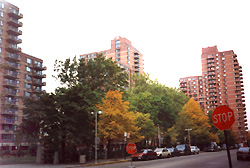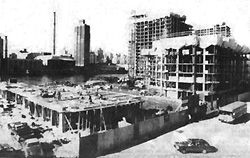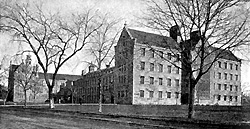|
by Neil Tandon for the Roosevelt Island Historical Society©
MANHATTAN PARK &
Surrounding this formal European-style sitting park is Northtown Phase II, better known as the MANHATTAN PARK residential complex. Opened in 1989, Manhattan Park was designed by Gruzen Samton and Steinglass and developed by Roosevelt Island Associates (a partnership of Starett Housing Corporation and Cohen Brothers Associates). The complex has five buildings, four offering a total of 884 market-rate rental units and the fifth offering 223 federally subsidized units under the Section 8 program. All five buildings have addresses on River Road, the street that loops this park.
Across the street is the MOTORGATE GARAGE COMPLEX, built in 1974. Motorgate may seem like just another car garage. It has a 1,000-car capacity, expanded in 1990 to 1,710. On top of that, it has won an award for the most use of cement in a given area.
The complex was the only boarding point for buses to Queens. For pedestrians, the towering, glass-enclosed structure on the garage's south side was once the only gateway to Roosevelt Island.
But the rewards were short-lived. The island's traffic restrictions were first amended to allow drop-offs and pick-ups. Eventually, traffic restrictions were lifted altogether. Despite these changes, Motorgate remains the main parking area for island residents. Among other functions, the complex has hosted modern sculpture exhibits and weekly produce markets. The island's post office and its only supermarket, Gristede's, are on the complex's ground floor. |




